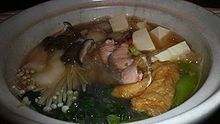- Chankonabe
-
Chankonabe (ちゃんこ鍋) is a Japanese stew (a type of nabemono or one-pot dish) commonly eaten in vast quantity by sumo wrestlers as part of a weight-gain diet. It contains a dashi or chicken broth soup base with sake or mirin to add flavor. The bulk of chankonabe is made up of large quantities of protein sources (usually chicken (quartered, skin left on), fish (fried and made into balls), tofu (or sometimes beef) and vegetables (daikon, bok choy, etc). While considered a reasonably healthy dish in its own right, chankonabe is very protein-rich and usually served in massive quantities, with beer and rice to increase the caloric intake. Leftover chankonabe broth can also later be used as broth for somen or udon noodles.
It is not made according to a fixed recipe and often contains whatever is available to the cook. It is traditionally served according to seniority, with the senior rikishi and any guests of the heya receiving first choice, with the junior wrestlers getting whatever is left. It is also a popular restaurant food, often served in restaurants operated by retired sumo wrestlers who specialize in the dish; the first of these, Kawasaki Chanko, was started in 1937 in the Ryōgoku district of Tokyo, home to many prominent sumo stables.
Chankonabe served during sumo tournaments is made exclusively with chicken, the idea being that a rikishi should always be on two legs like a chicken, not all fours like a cow or off one's legs entirely like a fish [1] (i.e., in a position of one who has just lost a match).
See also
Categories:- Japanese cuisine stubs
- Japanese soups and stews
- Sumo wrestling
Wikimedia Foundation. 2010.



